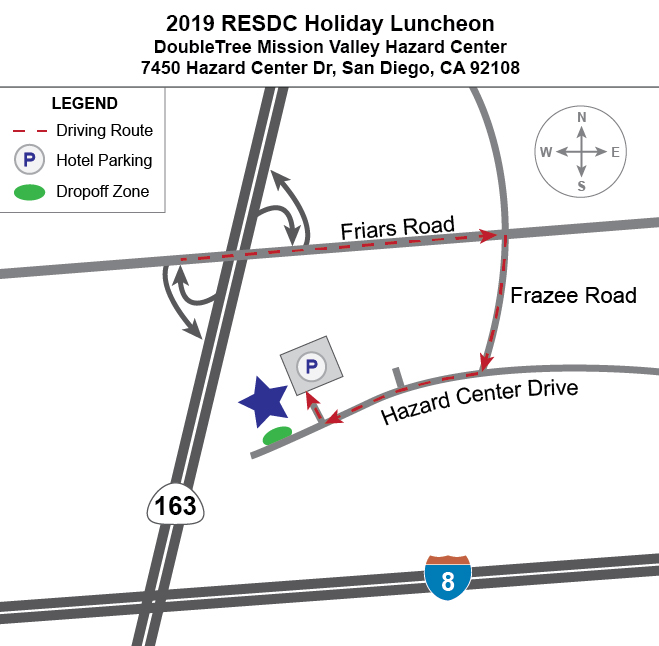November 2019
Honoring Yesterday – Protecting Tomorrow
Vol. 50, No. 11
November Calendar of Events
Weds., November 6, 3:30-5:00pm
RESDC Roundup South County
Galley At The Marina, 550 Marina Parkway,
Chula Vista, CA 91910
Mon., November 11
Veterans Day
RESDC & SDCERA offices closed for holiday
Thurs., November 14, 9:30am
RESDC Board of Directors Meeting
8825 Aero Drive, Suite 205
Sun., November 17, 2:00pm
Theatre Outing
Lamb’s Players Theatre, 1142 Orange Ave.,
Coronado, CA 92118
(Group tickets are sold out.)
Weds., November 20, 9:00am
SDCCU Financial Wellness Wednesday
9246 Lightwave Ave., San Diego, CA 92123
Thurs. – Fri., November 28-29
Thanksgiving Holiday
RESDC & SDCERA offices closed for holiday
![]() View the NETWORK
View the NETWORK
as a printable PDF
Are you on social media?
Stay connected with us!![]()
![]()
![]()
Quote of the Month
“The world is a book, and those who do not travel read only one page.”
▪ Saint Augustine
 2019 Holiday Luncheon
2019 Holiday Luncheon
NEW LOCATION!
The annual RESDC Holiday Luncheon will be held Thursday, December 12, at DoubleTree Hotel Mission Valley Hazard Center. More information & register →
President’s Message
By John J. McTighe
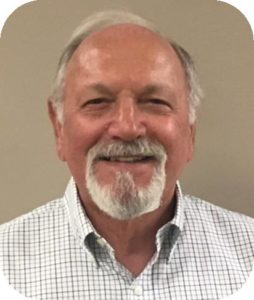 Last month we held our annual Coming Home event at the Las Colinas Detention and Reentry Facility (LCDRF) in Santee. I want to publicly express our thanks to Sheriff Bill Gore, Facility Commander Captain James Madsen, Administrative Deputy Corporal Rachel Lankard, Reentry Supervisor Bridget Hanagan, and the staff who assisted with the tours of the facility. Please see the article written by Board Member Chuck Brown for more information about this facility and the Sheriff’s overall detention services. While on the tour, I learned that the LCDRF encourages donations of used paperback books for the inmate library. If you’d be interested in making a book donation, the books must be soft cover, not exceptionally thick or large in size, and the content should be appropriate for adult women who are in recovery. The books can be dropped off with the staff in the lobby of the LCDRF at 451 Riverview Parkway, Santee.
Last month we held our annual Coming Home event at the Las Colinas Detention and Reentry Facility (LCDRF) in Santee. I want to publicly express our thanks to Sheriff Bill Gore, Facility Commander Captain James Madsen, Administrative Deputy Corporal Rachel Lankard, Reentry Supervisor Bridget Hanagan, and the staff who assisted with the tours of the facility. Please see the article written by Board Member Chuck Brown for more information about this facility and the Sheriff’s overall detention services. While on the tour, I learned that the LCDRF encourages donations of used paperback books for the inmate library. If you’d be interested in making a book donation, the books must be soft cover, not exceptionally thick or large in size, and the content should be appropriate for adult women who are in recovery. The books can be dropped off with the staff in the lobby of the LCDRF at 451 Riverview Parkway, Santee.
I recently saw an article in the newspaper discussing how scammers are increasingly targeting the elderly. This led me to look into the types of common scams and recommendations for how to avoid becoming a victim. AARP has a list of over 50 known scams on their Fraud Resource Center website at: www.aarp.org/money/scams-fraud. There are far too many to list in this article, but you can go to this website to learn how to avoid and spot common scams.
The San Diego County District Attorney has a website containing alerts to a number of scams. Many of them are the same as ones found on the AARP website, but there is more information on how to report if you suspect you or a loved one is a victim of any of these scams. Their website can be found at:
https://www.sdcda.org/preventing/alerts-advisories.html.
The Better Business Bureau has a list of scams on their website at: https://www.bbb.org/scamtips. In addition, they offer these ten suggestions to avoid becoming a victim of scams:
- Never send money to someone you have never met face to face.
- Don’t click on links or open attachments in unsolicited email.
- Don’t believe everything you see.
- Don’t buy online unless the transaction is secure.
- Be extremely cautious when dealing with anyone you’ve met online.
- Never share personally identifiable information with someone who has contacted you unsolicited.
- Don’t be pressured to act immediately.
- Use secure, traceable transactions when making payments for goods, services, taxes, and debts.
- Whenever possible, work with local businesses that have proper identification, licensing, and insurance.
- Be cautious about what you share on social media and consider only connecting with people you already know.
Scams that are perpetrated on the elderly often fall into the category of elder abuse. In my April 2018 column, I listed a number of recommendations from the National Committee for the Prevention of Elder Abuse’s report entitled Preventing Elder Abuse. I believe it would be helpful to list these once again here:
- Avoid isolation, which can lead to loneliness, sadness, and depression and increase the possibility of abuse or neglect, even self-neglect.
- Keep in touch with family members.
- Stay social and stay active. Keep in touch with old friends and make new ones.
- Consider volunteering in the community or becoming a surrogate grandparent or mentor to a child.
- Participate in religious and/or community activities.
- Don’t live with a person who has a history of violent or abusive behavior.
- Beware of family members or caregivers who might have a need for financial assistance or who have substance abuse issues.
- Be cautious in making financial decisions and monitor your financial affairs.
- Discuss any significant financial decisions or changes to legal documents with someone you trust completely before taking action.
- Beware of people who ask you to change your will or add their names to your bank accounts or titles on property.
- Keep your legal and financial documents in a safe place. Consider executing legal documents such as a will, living will, and a durable power of attorney for finances and health care.
- Beware of telephone solicitations and internet or mail scams. Avoid individuals who want you to make immediate purchase decisions.
- Safeguard your personal information and passwords.
If you have concerns that you have been a victim of any type of abuse, including financial exploitation, do not be afraid to discuss your concerns with someone you trust such as a family member, close friend, attorney, bank manager, etc. or to call Adult Protective Services. It is important to address any concerns as soon as possible. In San Diego County, Adult Protective Services serves adults 65 and older. They maintain a 24 hour a day, seven day a week phone reporting service at 800-510-2020 (within San Diego County) or 800-339-4661 (outside the County).
I’m not writing about elder abuse and senior scams to scare you, but rather to make you aware and cautious in your dealings with people and businesses. The old adage that “if something sounds too good to be true, it probably is” can apply here. Once again, if you suspect you’ve been a victim of scams, contact Adult Protective Services or local law enforcement.
On a positive note, I’m getting excited about our annual Holiday Luncheon which this year is being held at a new location, The DoubleTree Hotel Mission Valley Hazard Center, on Thursday, December 12th starting at 11:00 am. If you haven’t yet made your reservation, you can do so by Thursday, December 5th. Click here for more information about how to register. I hope to see you there. ◾
Surprise Medical Billings
By Stan Coombs, Director
 Anyone who hasn’t heard has to have been on Mars for the last year. There have been news articles, politicians have been pontificating for months, and now there just may be enough bipartisan support to bring something better.
Anyone who hasn’t heard has to have been on Mars for the last year. There have been news articles, politicians have been pontificating for months, and now there just may be enough bipartisan support to bring something better.
We’re talking about surprise medical billings, often received after folks with comprehensive health insurance are treated in “in-coverage hospitals,” watch their paperwork finalized as they exit, and, hopefully, are healing. Surprise billings average over $2,000 now, and can range over $100,000.
It happened to about 15% of hospital admissions across 38 states examined by the Health Care Cost Institute, a ratio that rose to 26% in Florida. Certain specialties were higher, 22% for patients with emergency room claims.
And the frequency is increasing. According to a different Stanford study, reported in Modern Healthcare, surprise billings showed up in 42% of cases in 2016, and averaged $2,040, after increasing 154% over six years.
How can this happen to an insured patient treated in an in-network hospital?. . . Usually when an out-of-network physician provides treatment at that in-network hospital. Since they’re out-of-network, they aren’t contractually restricted to negotiated insurance imbursements and can charge whatever they want.
“It’s kind of a built-in problem,” one researcher said. “Most private health insurance is based on networks. Patients get the highest value by choosing a doctor in the network.” But in emergency situations, patients often don’t know who’s treating them, or have the option of declining a needed procedure.
Other terms for these practices are “balance billings” and “pop-up services.” Balance billings happen when health insurance companies pay an out-of-network provider the negotiated amount they pay in-network providers, and the out-of-network provider bills the patient for the rest. One commentator suggested in-network hospitals sometimes even turn a blind eye and share the profits.
Pop-up services (independent labs, free-standing emergency departments, air ambulance service), may avoid network status and associated fee limitations, as a deliberate business model.
But not all Americans are equally vulnerable. An April 5, 2019 PEW Charitable Trusts article, by Michael Ollove, lists nine states that have comprehensive surprise billing protection laws – California, Oregon, Illinois, Florida, New York, New Hampshire, Connecticut, New Jersey and Maryland. They cover emergency and non-emergency departments, apply to both HMOs and PPOs, protect from financial liability, and regulate how insurers must pay providers and establish dispute-resolution processes. Another 16 states have limited protections.
The gaping hole in this picture is that these state laws protect consumers with commercial health insurance, Kaiser Family Foundation reports. They don’t apply to self-insured, employer-sponsored health plans, which cover 61% of privately insured employees. The federal government, not states, regulates self-insurance plans, and no federal law prohibits surprise medical billings in self-insured plans.
The issue looms large for Americans. A 2018 health tracking poll reported 67% were very worried or somewhat worried whether they can afford unexpected medical bills, exceeding the number similarly concerned about prescription drug costs, monthly health insurance premiums or even rent or mortgage costs.
Aside from patients, principal stakeholders in all this are medical providers and insurance companies. One commentator said the debate focuses on determining the correct insurance reimbursement to providers. “Payers don’t want to overpay, providers don’t want insufficient reimbursement.” He might also have added that patients don’t want unexpected, unaffordable additional costs!
Several states are working on balance billing legislation. Some have suggested tying provider fees to Medicare fees directly or through a related formula, and some propose tying fees to average medical prices within designated geographic areas.
The picture’s even fuzzier at the national level. Congress and the Trump administration have pushed for more transparency, on the assumption that informed folks choose cheaper options.
But one study found only 2% of folks with price information actually use it. Hospitals are adamantly opposed, and the other obstacles to patients selecting the cheapest alternative, mentioned above, wouldn’t be assuaged. Some critics claim the additional transparency could even cause costs to increase over time, as providers see competitors’ prices. The market rate could act as a floor rather than a ceiling in future negotiations.
The congressional House Ways and Means Committee is apparently considering banning surprise billings completely, and letting a committee of stakeholders decide how providers get paid for out-of-network cases.
It’s no surprise the medical and insurance industries are using their huge financial resources in this congressional battle. There’s little information available about lobbying specifically on surprise billing, but figures for all congressional lobbying on health are worth noting.
In 2018, they totaled $567.1 million, and through July 24th of 2019, another $295.9 million was spent, for a projected, annualized 2019 rate of about $592 million, or about $1.1 million per member of Congress. . .a figure up 254% over the last 20 years. ◾
Pension Facts
Public Pension Critics Have Their Champions
Pension Facts at a Glance
72%
72 cents of every
dollar CalPERS distributes in pensions is funded by investment earnings and member contributions (based on data over 20 years ending in June, 2018.)
By Chris Heiserman, Director
 If it seems like I frequently complain about critics attacking public retirement benefits, it’s because new examples of faulty reasoning and unfair commentary crop up nearly every week. In a recent opinion piece for the CalMatters news organization, former California Assemblyman and current Stanford Public Policy Professor Joe Nation warned that the huge pension debt of California’s public retirement systems cannot be ignored. Using much more conservative future projections of investment return rates than those employed by California public retirement plans, Nation claims that the unfunded liability of public pensions in the state tops $1.1 trillion and represents a debt of more than $80,000 per household.
If it seems like I frequently complain about critics attacking public retirement benefits, it’s because new examples of faulty reasoning and unfair commentary crop up nearly every week. In a recent opinion piece for the CalMatters news organization, former California Assemblyman and current Stanford Public Policy Professor Joe Nation warned that the huge pension debt of California’s public retirement systems cannot be ignored. Using much more conservative future projections of investment return rates than those employed by California public retirement plans, Nation claims that the unfunded liability of public pensions in the state tops $1.1 trillion and represents a debt of more than $80,000 per household.
Nation is often quoted in media articles and newspaper editorials and described as an “expert” on public pension issues. He is not. His bias against public retirement plans is readily apparent and his observations and conjecture about trends in the public pension arena are superficial at best. A major negative talking point suggested by Nation and other pension detractors is that overall public retirement plan liabilities have continued to rise or only slightly improve even though the stock market has soared in recent years.
This may sound like a simple math exercise but in truth its closer to comparing apples and oranges. There is no correlation between a growing economy and retirement plan debt. Pension financing is scheduled over 25-30 years or more. There have been cases (San Diego County, for example) where a state or local government took advantage of unexpected budget surpluses or higher revenues due to a robust economy to pay down some of their unfunded liability tab earlier than originally planned (and coincidentally reduce future interest expenses). However, most retirement systems budget to carry out their long-term funding timetables regardless of economic volatility.
In addition to using a conservative “riskless rate” of investment returns to calculate the largest possible unfunded liability number and make all retirement funds look overly expensive, Nation then carelessly assigns a portion of that future debt to every California household. Professor Nation doesn’t let logic or common sense get in the way of a dramatic storyline. He paints a gruesome fiscal picture inferring that every family in the state could be on the hook for $80,000 to cover unfunded retirement benefit promises made to retired public workers – until you realize three things: (1) the $1.1 trillion price tag calculated by Nation for unfunded pension liabilities is much larger than the amount state and local retirement plans base their future financing plans around; (2) the per household pension debt amount is just a simple, unscientific metric derived by applying population data from the state Department of Finance to the exaggerated unfunded pension debt figure; and, (3) whatever the accurate per household dollar figure might be, it is only a snapshot in time that is certain to slide lower as retirement funds carry out their long term financing schedules.
Of course, all this begs the question of whether a statewide per household number is a measurement with any relevance at all. There are literally hundreds of city, county, school and other special district retirement plans in California, all with their own separate level of unfunded liability.
Professor Nation also popped up in a recent article in The San Francisco Chronicle. The news item characterized what a “sweet deal” some public retirees enjoy as they cash pension checks larger than their final salaries at the end of their careers. The story highlighted several high-ranking police and fire retirees making more than $300,000 annually, and reported that 139 former city employees were collecting pensions over $200,000. Nation offered another dramatic sounding math calculation “to put these high pensions into perspective.” He said it would take $4 million in savings to produce a $200,000 annual pension for 25 years. I’m still wondering how this annuity example relates to traditional public sector pension plans where workers and their employers contribute to a large pooled investment fund and earnings on the fund covers the majority of every benefit paycheck.
To be clear on the “sweet deal” front, high level executives and safety officer brass who retire from public agencies after full careers (25-30 years) will usually be making close to their working salary when they enter retirement. Modest cost of living increases over a few years can easily push them beyond that.
And to put something else into perspective relative to these “high pensions,” as of June 2018 only 3.6% of the nearly 600,000 retirees, beneficiaries and survivors in the California Public Employees Retirement System (CalPERS) received more than $100,000 annual distribution. The average benefit for all retirees was $2,979 monthly ($35,748 annually). ◾
Coming Home 2019
By Chuck Brown, Membership Committee Chair
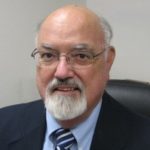 The 2019 Coming Home event began with a little late morning mixer that included a variety of finger foods, coffee, and soft drinks. Our thanks to Captain James Madsen, Lieutenant Steve Bulthuis, Corporals Rachel Lankard and Martha Gonzales, and Bridget Hanagan, Re-entry Supervisor for sharing their experiences at the Las Colinas Detention and Reentry Facility (LCDRF), which serves as the primary point of intake for women prisoners in San Diego County.
The 2019 Coming Home event began with a little late morning mixer that included a variety of finger foods, coffee, and soft drinks. Our thanks to Captain James Madsen, Lieutenant Steve Bulthuis, Corporals Rachel Lankard and Martha Gonzales, and Bridget Hanagan, Re-entry Supervisor for sharing their experiences at the Las Colinas Detention and Reentry Facility (LCDRF), which serves as the primary point of intake for women prisoners in San Diego County.
The facility opened in August 2014, replacing the old Las Colinas Detention Facility that opened in 1979. The new facility is staffed by approximately 278 sworn employees and 143 professional staff members. The new facility provided the opportunity to implement new operational philosophies for detention and re-entry into the community.
“Open Booking” replaces the traditional Intake/Booking setting where inmates were moved between holding cells as they complete the booking process. In the Open Booking approach, inmates are seated in an open seating area and will be called to the areas of the booking process. During this time, the inmate will also have access to telephones and restrooms.
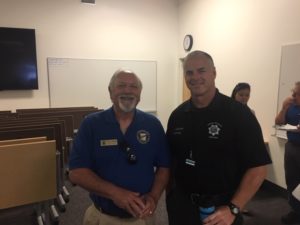
RESDC President John McTighe and LCDRF Facility Commander James Madsen at the 2019 Coming Home Event.
“Direct Supervision” places deputies in the inmate housing areas rather than being segregated in deputies’ stations apart from the inmates. This allows for greater interaction between inmates and staff and the ability to resolve conflicts before they become more serious problems.
“Reentry Services” have been available, at various levels, to inmates for many years. With improved facilities and academic/pre-employment classes, reentry services are a key emphasis of LCDRF. Inmates will leave better prepared for successful reintegration to the community, lowering the chance of reoffending. The recidivism rate for LCDRF is significantly lower than the state average.
LCDRF provides a range of housing options for inmates requiring segregation or special care for medical or mental health needs.
The Sheriff’s Detention Bureau oversees seven facilities that house over 5,000 inmates on any given day. Las Colinas, with an average population of over 800, is the base for female inmate re-entry and the counterpart for male inmates is the East Mesa Detention Facility in South Bay. The detention operation is a marvel, in itself. The staff is responsible for housing, feeding, clothing, educating, transporting and banking services for the inmates at all facilities. Where else can you find an operation that, at the same time, has to combine the businesses of hotels, restaurants, department store, vocational school, metropolitan transit, and banking? ◾
SDCCU Financial Wellness Wednesdays
Breezing Through the Holidays
 When: Wednesday, November 20, 2019, 9 am
When: Wednesday, November 20, 2019, 9 am
Where: San Diego Workforce Partnership, 9246 Lightwave Ave., San Diego, 92123
What: Learn how to responsibly handle the spending pressures and choices of the holiday season. Topics discussed in this presentation include: setting a holiday budget, shopping for gifts and managing other holiday costs.
RSVP: For more information or to RSVP for this free event, contact Brandon Gentry, at: bgentry@sdccu.com or call: (858) 263-8078. ◾
Recent Events
-
SDCERA Health Program Update. At their October meeting, the SDCERA Board of Retirement approved a staff recommendation that the $5.53 monthly health administration fee, charged to retirees for management of their sponsored health insurance programs, be decreased 9.5% to $5.00 for 2020. The fee applies to each health insurance premium, of each retiree or spouse covered.
-
County adopts “Aging Roadmap” with Eye to the Future. The San Diego region’s older population is growing rapidly, and the county has a plan it hopes will bolster services for seniors. County Supervisors adopted a comprehensive regional plan, dubbed the “Aging Roadmap,” intended to meet the needs of older adults in the region and keep seniors in their homes as long as possible. Developed by a wide range of community partners who support older adults, the Roadmap is supportive of the County of San Diego’s Live Well San Diego vision and is guided by the County of San Diego Health and Human Services Agency, Aging and Independence Services (AIS). For more information visit: http://www.livewellsd.org/. ◾
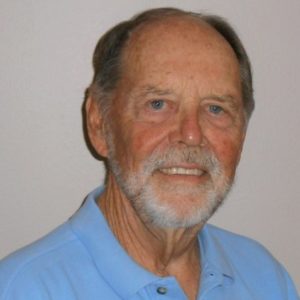 Board Member Profile
Board Member Profile
Stan Coombs
A member of the RESDC Board of Directors since December 2006, Stan retired from the County Housing and Community Development Department in 1998 with 25 years of County service. He also worked on the staff of a County Supervisor and spent time in the Office of Management and Budget. Prior to joining the County, Stan worked at the City of San Diego and in non-profit management.
Stan has Bachelors and Masters Degrees from San Diego State University. In addition to volunteering with RESDC and serving currently as First Vice President, his enjoyable retiree activities include cycling, travel, reading, home improvement, and children and grandchildren.
He has been married to Diane for 33 years. They have five children and eight grandchildren. Stan’s favorite travel experiences were Mediterranean and Baltic tours. ◾
See’s Candy Certificates
Great Holiday Gifts!
Purchase from RESDC for Less!

 See’s Candy is now priced at $21.00 per pound if you buy it at one of their stores. RESDC members can purchase See’s gift certificates from us at $18.00 each.
See’s Candy is now priced at $21.00 per pound if you buy it at one of their stores. RESDC members can purchase See’s gift certificates from us at $18.00 each.
If you would like to order certificates from our office, please address an envelope to RESDC, 8825 Aero Dr., Suite 205, San Diego, CA 92123. Enclose a check for $18.00 for each certificate.
Also enclose a business size (#10) self-addressed stamped envelope, as the certificates will not fit in a small envelope. To order up to five certificates please put one forever stamp (currently 55¢) on a self-addressed envelope. If you order over five certificates, please put 70¢ postage on the self-addressed enclosed envelope. Please include a stamped envelope for every 10 certificates. Candy certificates are redeemable at any of the See’s retail stores for ready-packed or specially packed boxes.
These certificates do not have an expiration date. See’s Candy certificates are available through RESDC all year long. ◾
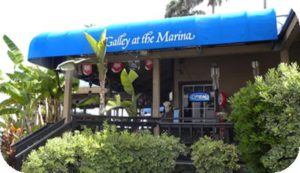 RESDC Roundup
RESDC Roundup
South County
Our North County Roundup was well attended and everyone had a great time! We are pleased to announce we will be heading to the South Bay area this month, visiting the Galley At The Marina in Chula Vista. The Roundup provides an opportunity to catch up over libations and appetizers with RESDC leadership and fellow members. No reservation required (no host bar, no host food). Come meet with old friends and make some new ones!
Date: Wednesday, November 6, 2019
Time: 3:30—5:00 pm
Location: Galley At The Marina
550 Marina Parkway, Chula Vista, CA 91910 ◾
Bits and Pieces
Editor’s Note: We would like to continue printing some Bits and Pieces items in this newsletter about our members.
If you have taken an interesting trip or have had an intriguing event happen recently, please let us know so that we can share your story with our members.
If you have reached an exciting birthday, or wedding anniversary, please call Karen Hazel, RESDC Editor, at (866) 688-9229. You can also write to Karen at RESDC, 8825 Aero Drive, Suite 205, San Diego, CA 92123. You can also send your information to us by email at: resdc@resdc.net. ◾
NEW LOCATION for 2019 Holiday Luncheon
DoubleTree Hotel Mission Valley Hazard Center
 When: Thursday, December 12, 2019, 11:00 am – 2:00 pm
When: Thursday, December 12, 2019, 11:00 am – 2:00 pm
Lunch is served at 11:30 am
Where: NEW LOCATION: DoubleTree Hotel Mission Valley Hazard Center
7450 Hazard Center Dr., San Diego, CA 92108
Driving directions will appear in the November and December NETWORKs.
Menu: Roast Turkey or Vegetarian Lunch
Cost: $24 per person
Program: President’s Welcome, introduction of guests, approval of the 2020 budget, and music performed by Silverwood Quartet, a premier music ensemble.
Directions: From I-8 E or W, take Hwy 163 N, exit Friar’s Road East and turn left; from Hwy 163 S, exit Friar’s Road East and turn right. Turn right on Frazee Road. Turn right on Hazard Center Drive. Turn right at Hazard Center West Driveway (2nd light) and go straight back into the “Hotel Self Park” parking. Take a ticket, which you can get validated at the luncheon check-in table for free parking.
Registration: Registration forms and payment must be received in the RESDC office by Thursday, December 5th. There are no refunds for cancellations after December 5th.
Reserved tables will be provided only for groups of ten who pay for the entire group with one check or one credit card. No exceptions.
If wheelchair seating is required, please call our office at (619) 688-9229, or you may inform us on your registration form.
Name badges and opportunity ticket packets should be picked up at the check-in table at the event. They will not be mailed.
- Register Online: Go to www.resdc.net/events and click the green “Register” button. Use the email associated with your member account. Click “Add guest” to add additional registrants for $24 each. To pay for yourself and guests, click “Pay Online” and pay with credit card.
- Register by Phone: Call the RESDC Office at (619) 688-9229 during our hours of 9 am – 2 pm Mon-Fri.
- Register by Mail: Fill out the Registration Form. Make a check payable to RESDC for $24 per person. Mail registration form, along with check to RESDC, 8825 Aero Dr., Suite 205, San Diego, CA 92123 ◾
Welcome New Members
Mary J. Coffin – Public Defender
Sirous Deylamian – Public Works
Georgia C. Knippenberg – Superior Court
Regina D. Lindsey-Cooper – Superior Court
Alva D. Mireles – Probation
June V. Nygaard – Health & Human Services
Cecile Sanchez – Environmental Health
Monica C. Stanton-Torres* – Sheriff
Gary J. Werchak – Human Resources
Linda K. Wheeler-Calderone – Assessor Recorder County Clerk
*Associate Member
The surviving Spouse of a member is eligible for RESDC membership. For enrollment assistance, please call: (866) 688-9229. ◾
NETWORK is the official monthly newsletter of the Retired Employees of San Diego County, Inc. (RESDC), a private non-profit organization.
The information printed in the NETWORK is believed to be from reliable sources. However, no responsibility is assumed by the NETWORK for inaccuracies contained herein.
Business and Inquiries: Business matters and address changes may be recorded on our voicemail at any time, call (866) 688-9229. Please spell your name so the correct member record can be located.
Retired Employees of San Diego County, Inc.
8825 Aero Drive, Suite 205 | San Diego, CA 92123
Office Hours: 9 a.m. to 2 p.m. Monday through Friday
TELEPHONE: (866) 688-9229 Toll Free
FAX: (619) 688-0766
E-MAIL: resdc@resdc.net


